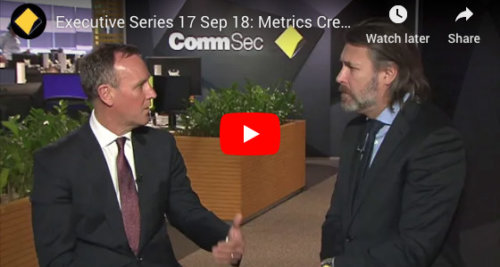Understanding private credit
Growth in non-bank lending providing new options for companies and investors, says Metrics Managing Partner, Andrew Lockhart in ASX Investor Update.
Many Australians are familiar with real-estate investing through home ownership or buying a rental property. But what about investing in real estate debt?
That is the essence of private credit, a fast-growing alternative asset class that targets capital-seeking companies and income-seeking investors.
Preqin, an alternative assets researcher, estimates private credit worldwide will nearly double in size to US$2.8 trillion by end-2028. That is partly because banks could reduce lending to certain types of assets, forcing companies to seek other funding sources. That, in turn, could create opportunities for investors.
Private credit (also referred to as private debt) occurs outside traditional bank lending or public debt markets. Although private credit covers a wide range of lending strategies (including funding for acquisitions of distressed assets), it is mostly used for direct lending to large and small organisations.
For example, a property developer building an apartment block might use private credit to fund the project. Here, the developer cannot secure traditional bank funding because their bank is reducing its exposure to apartment developments in certain locations (possibly because it already has too much exposure).
The private credit fund that provides capital to the developer generates returns through interest payments on the loan. Investors in the fund hope to receive a stream of distributions – and potentially higher income return than they could earn in a term deposit or from equities.
The main risk is loan default. Just as banks assess borrowers and monitor loans, so too do private credit providers. If the property developer in this example cannot repay the loan, the private debt fund (and its unitholders) has a problem.
Private credit funds typically spread risk by having many loans in their portfolio. But the potential for loan default – at a time when insolvencies in the property sector are rising – is an important risk to consider.
Transparency is another consideration. Unlike ASX-listed securities, private loans do not trade on exchanges. Some private credit markets can be opaque, less liquid and have less price discovery compared to exchange-listed assets where an asset’s market price is always known and securities have greater liquidity. One way to manage this risk is to consider private credit funds quoted on ASX.
Metrics Credit Partners, a leading non-bank lender and alternative asset manager in Australia, has two ASX-listed funds.
These funds provide exposure to private credit through a Listed Investment Trust structure. Investors buy or sell units in the trusts, both of which have target yields and aim to pay monthly distributions.
ASX Investor Update asked Andrew Lockhart, Managing Partner of Metrics, about the features, benefits and risks of including private credit in portfolios.
Andrew Lockhart (AL): There are a few reasons. For investors, private debt has the potential to deliver higher income returns. Also, the income stability associated with the underlying asset class is attractive to many investors, in Metrics’ view. For companies, private credit is becoming a more important source of funding.
AL: Yes. At the moment, credit demand from companies across the market remains strong. Metrics has invested substantially in its loan-origination capabilities and relationships with borrowers, which in turn is driving more opportunities to lend funds and create opportunities for investors.
AL: Metrics recently completed a successful capital raising for one of our funds (the Metrics Master Income Trust) that raised more than A$195 million. This involved a placement to wholesale investors and we opened up the capital raising to retail investors (through a unit-purchase plan) to acquire up to A$30,000 worth of new units. Metrics’ unlisted retail fund (Metrics Direct Income Fund) has also had strong fund inflows in the past few years.
AL: Our loans are bespoke. It might be to finance the core operations of a business or fund its growth through capital expenditure. Or Metrics might provide a funding line to support a company’s working capital requirements. The loan could be for a large or small organisation. In property, Metrics might provide a loan for an industrial property development or a new high-density apartment. The terms and conditions of each loan are designed to match the intended use of the proceeds – and the risk profile of the asset.
AL: Before issuing a loan, Metrics does a lot of work to get comfortable that the loan can be serviced. We need to know if the organisation can service the loan under different conditions, for example, rising interest rates. We then structure the loan to ensure there are sufficient lending protections, and that the loan will still be paid if the organisation’s credit quality deteriorates.
For more on this topic, see ‘Q&A Cash Flow is King’ interview.
AL: Metrics has not seen any deterioration in the credit quality of its portfolio. We are the largest non-bank real estate lender in the country and 60% of our assets under management are focused on commercial real estate. So, we have a good view of the property sector. What we see now is strong demand for residential property, which is partly due to strong migration, low property vacancy rates and rising rents.
AL: As an asset class, private credit has lower risk than equity because debt sits higher in the capital structure in the event of a liquidation. In our experience, that appeals to investors and advisers who want to reduce the volatility of a portfolio, while still potentially generating attractive income.
At the same time, other investors might be looking to replace equities in their portfolio with higher-yield credit, such as private credit. Thus, private credit can play dual roles in portfolios: as a defensive investment that can potentially provide capital stability and higher income; and as a replacement asset for equities that can provide income and potential equity upside through the skill of the manager.
For more on this topic, see ‘Why private debt can play offence and defence in your portfolio’ interview.
AL: The biggest risk is an investor is exposed to the risk of credit loss in the event of a loan default. If the credit quality of the borrower deteriorates, and the loan default becomes a loss, there is a potential risk that investors could lose their capital. But the same risk is true for equity investors in companies that cannot repay their loans. There are also a range of macroeconomic risks associated with private credit, for example, interest rates and the state of the economy. Again, these risks are not unique to private credit.
AL: We expect private credit worldwide to continue its growth. Regulators want to reduce systemic risks in financial markets by ensuring banks are appropriately regulated. That will mean more organisations will have to turn to non-bank lenders for funding in coming years. In Australia, we don’t have a bond market of any size or scale, so private credit has an important role in supporting the growth of quality companies and projects. But for all the potential, private credit is only as good as the managers behind it, in terms of how they assess and monitor loans, manage risk and allocate capital.
Other News
Portfolio Construction Guide 2025: The lowdown on commercial real estate lending
In the latest Money Management Portfolio Construction Guide, Metrics Managing Partner Andrew Lockhart offers an insightful deep dive into the…
Metrics Real Estate Multi-Strategy Fund IPO (ASX:MRE) exceeds target raise
Metrics Credit Partners (Metrics) has announced the official closing of the initial public offering (IPO) for stapled units in the…
INSIGHTS
MCP Income Opportunities Trust (MOT) lists on ASX
Sydney, 29 April 2019: The Trust Company (RE Services) Limited (ABN 45 003 278 831) (Responsible Entity) is the responsible…
MCP Master Income Trust wins Lonsec Listed Fund Award
The award came a year after MXT was listed on the Australian Securities Exchange






